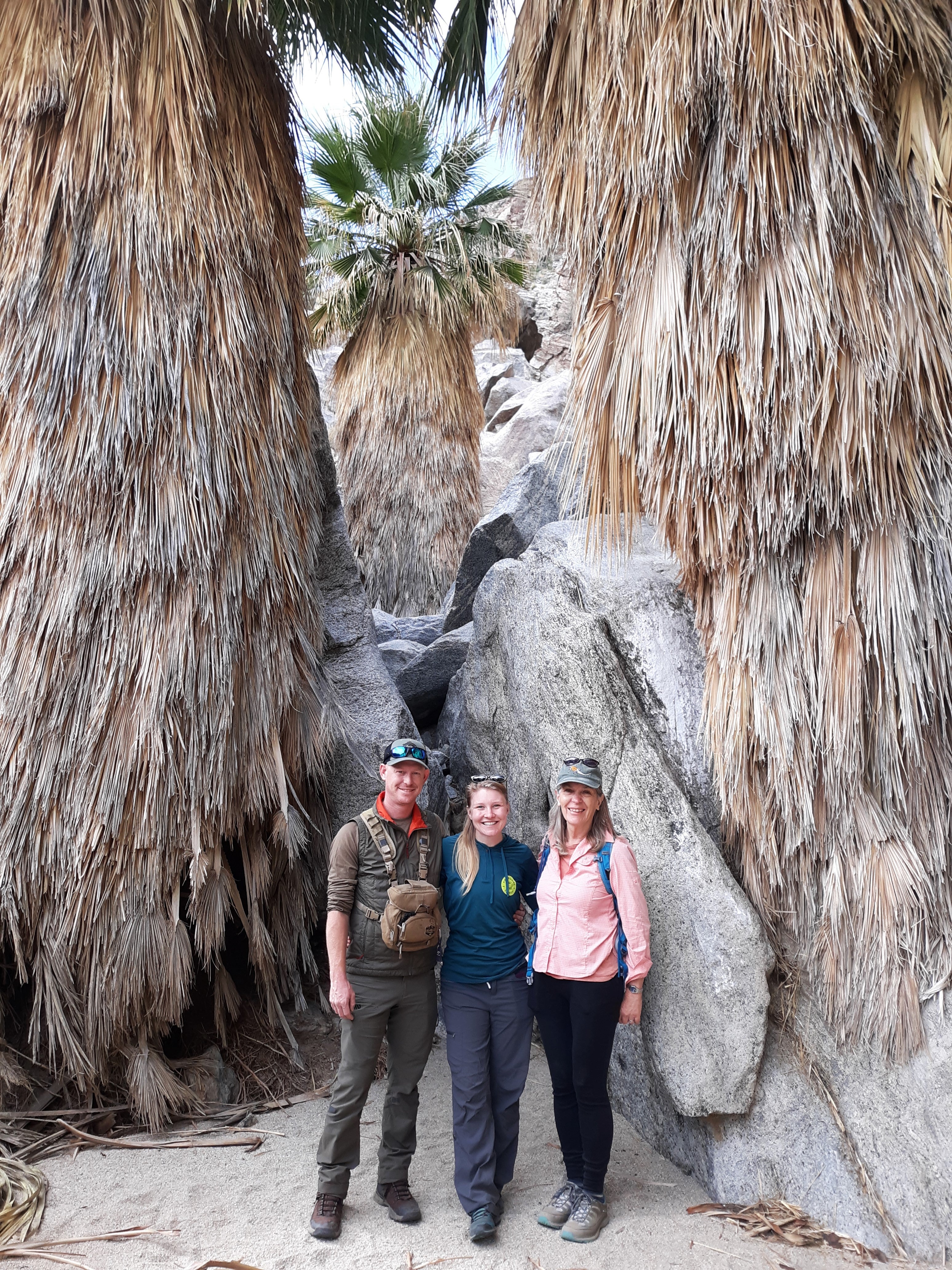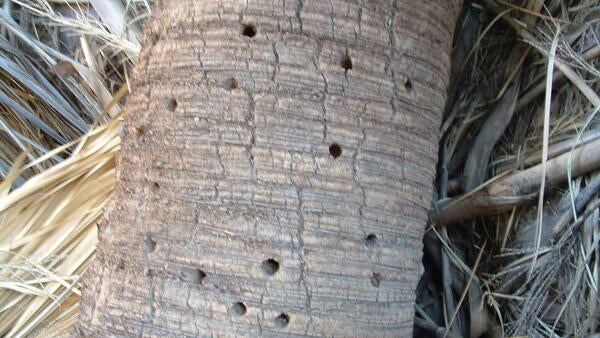How did desert fan palm oases come to be?
“Science is a way of thinking much more than it is a body of knowledge.” — Carl Sagan
The major deserts of North America are defined by climate and vegetation. There are some plants that ignore individual desert boundaries. Creosote bushes are found in the Mojave, Colorado, Sonoran, and Chihuahuan Deserts. Ocotillo occur in the Colorado, Sonoran, and Chihuahuan Deserts. Ironwood occur in the Colorado and Sonoran Deserts.
But there are some plants that by their presence define a single desert region. The Great Basin Desert is dominated by sagebrush (Artemisia tridentata). The Mojave Desert is delineated by the occurrence of two species of Joshua trees (Yucca brevifolia and Y. jaegeriana) along with blackbrush, (Coleogyne ramosissima). The Sonoran Desert, with its bimodal winter and summer rainfall pattern includes saguaro cacti (Carnegiea gigantea), found nowhere else. The Chihuahuan Desert has almost all its rainfall coming during the summer, and it is the only place where you can find lechuguilla (Agave lechuguilla). North America’s hottest and driest desert, the Colorado Desert is the only place where smoke trees (Psorothamnus spinosus), Schott’s indigo bush (Psorothamnus schottii), and desert fan palms, (Washingtonia filifera) grow naturally, although some of these palms do occur just beyond the Colorado Desert margins south, further into Baja California, Mexico. Still, draw a polygon that encompasses every known, naturally occurring desert fan palm oasis, and you have a rough map of the perimeter of the Colorado Desert.
Desert fan palms’ range represents an enigma. While limited to the hottest, driest North American desert, unlike typical desert plants, they lack structural or physiological adaptations for surviving a hot and dry climate. Rather they metaphorically “thumb their leafy noses” at those plants and animals that have adapted to this harsh environment, sporting huge green leaves that transpire water vapor back into the air as if they were living in the wet tropics. Rather than deep roots searching for hidden seams of moisture, their roots are relatively shallow. They exist as they do because they are restricted to those rare desert locations where earthquake faults bring groundwater to or near the surface.
Despite, or perhaps because of, the palms’ water-wasting, extravagant lifestyle, desert fan palm oases are biodiversity “hot spots.” They provide refugia for several bat species, including the western yellow bat (Lasiurus xanthinus), which is rarely found anywhere but in the skirts of fan palms. The palms provide nesting materials and structure for Scott’s orioles. Western bluebirds, American robins, and cedar waxwings are often abundant winter guests in palm oases, consuming huge quantities of palm fruits. Coyotes and foxes feast on the fruits the birds miss. Carpenter bees nest in the palms’ dried fruiting stalks. Monarch butterflies often winter in the palms, clinging to the palm skirts and perhaps feasting on the sugary deposits on the skins of the palm fruits. Palm-boring beetles, the largest species of the wood-boring beetle family, are endemic to desert fan palms. Barn, long-eared, great horned owls, and western screech-owls all roost and nest in fan palm oases. Desert fan palm oases are clearly important desert landscape features to many other species, including we humans. However, there are competing hypotheses as to just how they came to reside in the Colorado Desert.
One hypothesis posits that these palms are, like red-spotted toads, hold overs from the wetter glacial maxima of the Pleistocene Epoch. Their current distribution being just remnants of what was perhaps once a much broader, more continuous distribution along the creeks, rivers, and lakes of that previous geologic era. An alternative hypothesis suggests that the colder Pleistocene climate pushed the palms down into what is now Baja California, and that humans, including the Cahuilla and their trading partners brought palm seeds back north and planted them. The Cahuilla valued and continue to value the palms, for their fruits as food, and the large leaves as building materials. Two competing hypotheses, remnants of a once broader distribution versus more recent cultivation by indigenous people, but which one provides the best explanation for the fan palms’ current distribution? This is where science comes to the rescue. To distinguish between two competing hypotheses, scientists make predictions based on assumptions that are restricted to one hypothesis but not the other.
One question might be what was the distribution of the palms during the Pleistocene? Unfortunately, the fossil record is incomplete at best. However, paleontologists working in the badlands of Anza Borrego Desert State Park have reconstructed the Pleistocene landscape based on geology and fossils, and described a very non-desert scene of meandering wetlands bounded by forests that included Washingtonia palms. That confirms that palms were present and were more broadly distributed somewhere around 20,000-40,000 years ago. That finding supports the remnant distribution hypothesis, but it doesn’t necessarily eliminate the possibility that the indigenous cultivation hypothesis couldn’t also be true.
If the indigenous cultivation hypothesis was true, then we should expect that current palm oases should be primarily located in association with historical human occupation sites. For Palm Canyon in south Palm Springs, the various oases in the Indio Hills including Thousand Palm Canyon, as well as the palm oases in the Anza Borrego Desert State Park, that prediction has been validated by the extensive broken pottery sherds found near each of those sites. There are, however, many palm oases up in steep-sided canyons where village sites would be very unlikely. One possibility could be that the remote, steep canyon oases represent “plantings” by coyote, robin and bluebird scat, from fruits these animals could have consumed near village sites.
So far, our hypothesis testing is not providing an unequivocal answer. Do not give up yet, as the best hypothesis test might come from an unlikely field assistant, the palm-boring beetle. These beetles co-evolved with palm trees. The adult females only lay their eggs on a palm tree, probably somewhere near the crown. Her eggs then hatch and the tiny larvae, called grubs, then bore into the palm’s core eating wood fiber as they go. If the palm is healthy, it is likely that it will be able to evict the grubs, or at worst withstand and survive their intrusions. If the palm is old and water stressed, the grubs might eat enough of the fibers to kill the tree. The grubs live inside the palm’s trunk for as many as seven years, then when they reach the size of an adult human thumb, metamorphose into an adult, emerge from the trunk leaving a twenty-five-cent piece-sized exit hole. The adult beetles then mate and lay a new cohort of eggs and then die within just a few days after emerging. They are clumsy fliers and probably never go beyond the oasis where they emerged.
I have found these diagnostic palm-boring beetle exit holes in every palm oasis I have visited. Steep-sided canyon oases and flat canyon bottom oases alike. Under the “cultivation hypothesis” scenario, it would be difficult to explain how or why the humans would have brought the beetle grubs with them. Under the remnant distribution hypothesis, we should expect most if not all the oases should include a population of palm-boring beetles, and that is exactly what we see.
Nullius in verba
Go outside, tip your hat to a chuckwalla (and a cactus), think like a mountain, and be safe.

